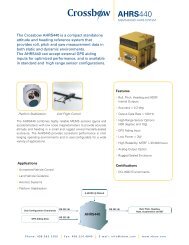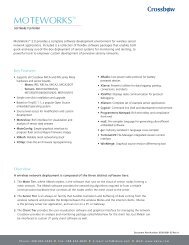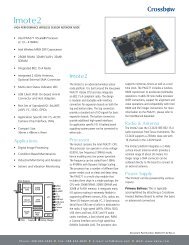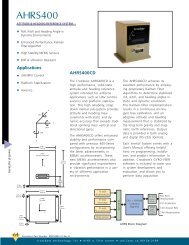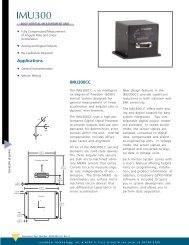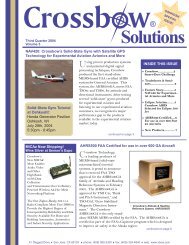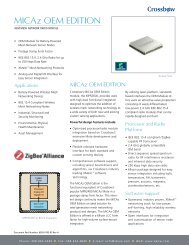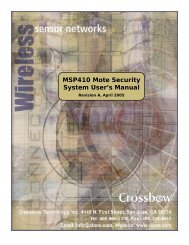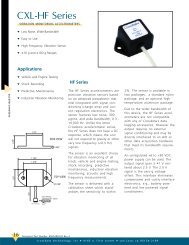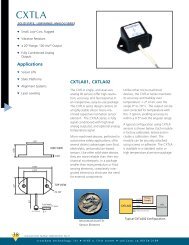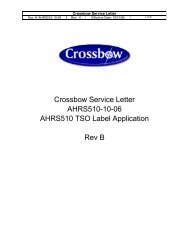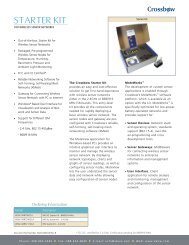MTS/MDA Sensor Board Users Manual
MTS/MDA Sensor Board Users Manual
MTS/MDA Sensor Board Users Manual
You also want an ePaper? Increase the reach of your titles
YUMPU automatically turns print PDFs into web optimized ePapers that Google loves.
where:<br />
Rthr = R1(ADC_FS-ADC)/ADC<br />
a = 0.00130705<br />
b = 0.000214381<br />
c = 0.000000093<br />
R1 = 10 kΩ<br />
ADC_FS = 1023<br />
ADC = output value from Mote’s ADC measurement.<br />
<strong>MTS</strong>/<strong>MDA</strong> <strong>Sensor</strong> <strong>Board</strong> User’s <strong>Manual</strong><br />
3.4 2-Axis Accelerometer (<strong>MTS</strong>310 Only)<br />
The accelerometer is a MEMS surface micro-machined 2-axis, ± 2 g device. It features very low<br />
current draw (< 1mA) and 10-bit resolution. The sensor can be used for tilt detection, movement,<br />
vibration, and/or seismic measurement. Power is controlled to the accelerometer by setting signal<br />
PW4, and the analog data is sampled on ADC3 and ADC4. The accelerometer at location U5 is<br />
an ADXL202JE and the full datasheet is available at http://www.analog.com. A summary of<br />
specification is provided in Table 3-2 below for reference.<br />
Table 3-2. Summary of ADXL202JE Specifications.<br />
Channels X (ADC3), Y (ADC4)<br />
G-range ±2 g (1 g = 9.81 m/s 2 )<br />
Bandwidth DC-50 Hz (controlled by C20, C21)<br />
Resolution 2 mG (0.002 G) RMS<br />
Sensitivity 167 mV/G ±17 %<br />
Offset 2.5 V ±0.4 V<br />
NOTE: The ADXL202 sensitivity and offset have a wide initial tolerance. A simple calibration using<br />
earth’s gravitational field can greatly enhance the accuracy of the ADXL202 sensor. By rotating the<br />
sensor into a +1 G and a –1 G position, the offset and sensitivity can be calculated to within 1 %.<br />
3.5 Two-Axis Magnetometer (<strong>MTS</strong>310 Only)<br />
The magnetometer circuit is a silicon sensor that has a unique bridge resistor coated in a highly<br />
sensitive NiFe coating. This NiFe coating causes the bridge resistance of the circuit to change.<br />
The bridge is highly sensitive and can measure the Earth’s field and other small magnetic fields.<br />
A useful application is vehicle detection. Successful test have detected disturbances from<br />
automobiles at a radius of 15 feet. The sensor is the Honeywell HMC1002 sensor. A detailed<br />
specification sheet is found at http://www.ssec.honeywell.com. The output of each axis (X, Y) is<br />
amplified by an instrumentation amplifier U6, U7. The amplified output is available at ADC5<br />
and ADC6. Power is controlled to the magnetometers by setting signal PW5. Each<br />
instrumentation amplifier (U6, U7) can be tuned using the digital potentiometer PT1 that is<br />
controlled via the I2C bus.<br />
WARNING: The NiFe core of the magnetic sensor is extremely sensitive. However, it is also<br />
subject to saturation. Saturation occurs when the sensor is exposed to a large magnetic field.<br />
Unfortunately the <strong>MTS</strong>310 circuit does not have an automatic saturation recovery circuit<br />
(set/reset). This limitation prevents the magnetometer from being useful in applications<br />
Page 8 Doc. # 7430-0020-05 Rev. A



